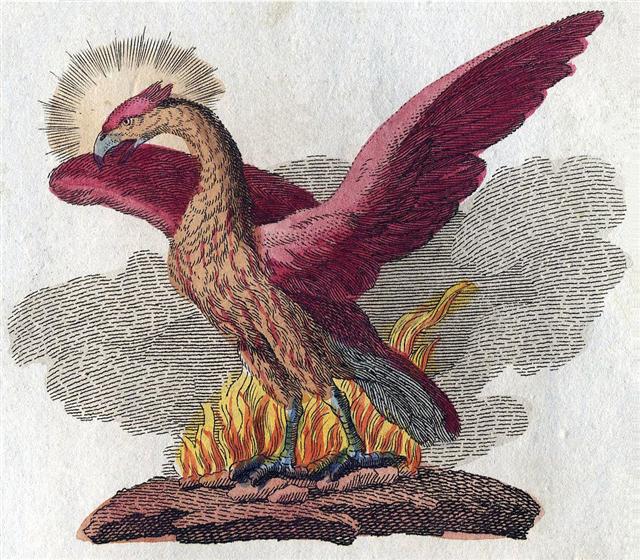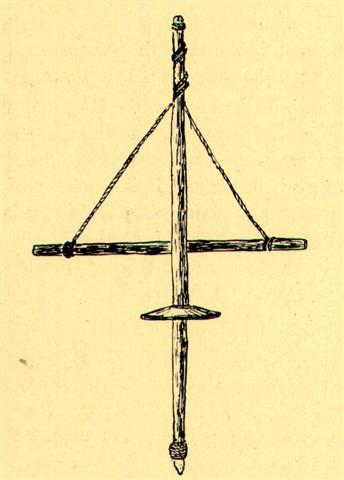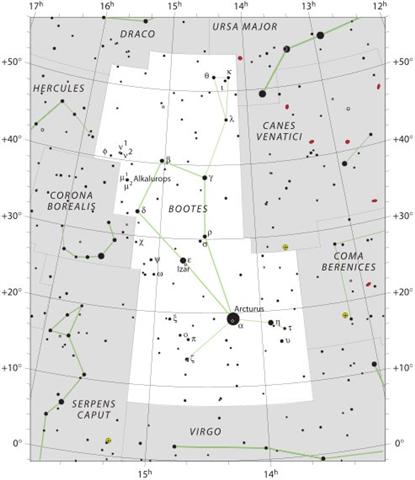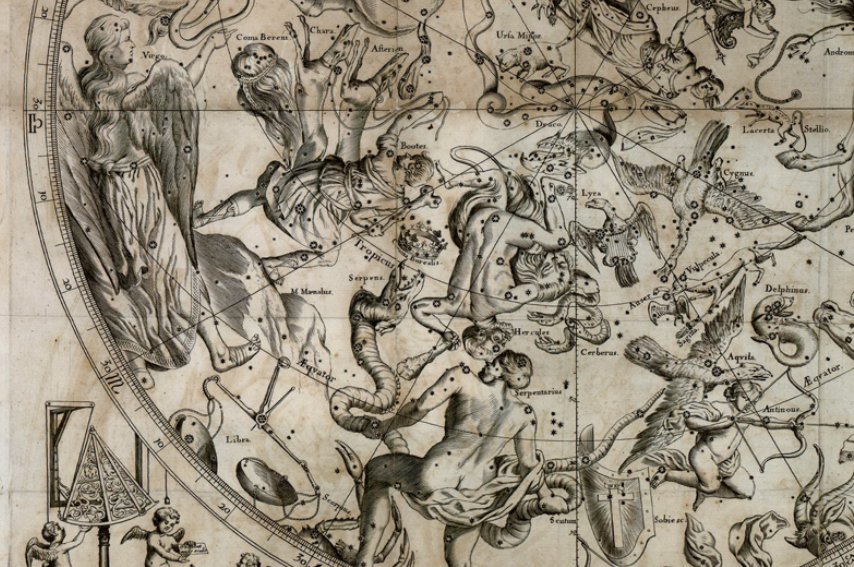34. An extraordinary glyph arrives after Cb1-5, and this was 392 (= 365 + 27) days later than the somewhat similar structural design in Ca1-6:
At the time of rongorongo and at Ca1-5 the Phoenix (*) constellation - represented by Ankaa - rose in the day after the Julian equinox, which corresponded to the night when black Raven and the Southern Cross (†) were at the Full Moon.
Before I had time to take notes the information was gone from my TV screen. But what remains in my memory must be retold. There was somewhere among the 'Paradise Islands' - which ought to have been located close to New Guinea where the birds of paradise are thriving - a species which I think might have been the origin of the mythical Phoenix. It laid a single great white egg and after some time (27 days if I remember it right) a rather fully grown chicken emerged from the ashes in which his mother had dug a properly located hole. ... 'In Upper Egypt', wrote Sir James G. Frazer in The Golden Bough, citing the observations of a German nineteenth-century voyager, 'on the first day of the solar year by Coptic reckoning, that is, on the tenth of September, when the Nile has generally reached its highest point, the regular government is suspended for three days and every town chooses its own ruler. This temporary lord wears a sort of tall fool's cap and a long flaxen beard, and is enveloped in a strange mantle. With a wand of office in his hand and attended by men disguised as scribes, executioners, and so forth, he proceeds to the Governor's house. The latter allows himself to be deposed; and the mock king, mounting the throne, holds a tribunal, to the decisions of which even the governor and his officials must bow. After three days the mock king is committed to the flames, and from its ashes the Fellah creeps forth ... This hole had to be on the slope of an active volcano and the temperature in the hole she had dug with her powerful feet down into the ashes had to keep a temperature close to 95º Fahrenheit. His mother had fought with other such birds in order to secure a good hole which had exactly the right temperature for hatching out her offspring. Unfortunately I cannot recall with certainty what the name of this species was, but the bird was sooty black all over and looked rather similar to a raven. Later I investigated further by way of the internet and concluded that this bird born from the ashes ought to be a close relative to the greater of the Melampitta pair (i.e. Megalampitta giganteus) - a curious character who has its nest down in limestone sinkholes and who has stubby wings from climbing up and down the walls inside such a hole: "All my records of Greater Melampittas were near sinkholes. The significance of these formations to the bird was called to my attention by Wanggasten villagers, who (like many New Guinea people) possessed detailed knowledge of local birds and gave me local-language names and accurate life history accounts of over 100 bird species familiar to them. When I first heard the song that I later identified as belonging to M. gigantea, my guides said that it came from an all-black bird named suaran. They described how the suaran differed in body size, bill, eye color, tail length, tail shape, and habits from other allblack birds such as the Trumpet Bird (Phonygummus keraudrenii), Spangled Drongo (Dicrurus hottentottus), and Australian Crow (Corvus orru). The characteristics of the suaran that all Wanggasten villagers mentioned first were that it was black, and that it roosted and nested underground in deep sinkholes. These remarkable roosting habits were confirmed on my first sighting of this melampitta. Our high-altitude camp (1,140 m) was at the edge of a narrow, vertical-walled trench 5 m deep. At 18:15 on the first night that we occupied this camp, as light was fading and bird activity was decreasing, my Wanggasten guide and I returned to camp and began talking loudly. A large black animal scurried up the opposite-facing wall of the trench and then out of the trench along the ground into the forest. At first glance I assumed from the animal’s movements that it was a rat, but I then saw that it was a Greater Melampitta. On subsequent days I found at least three individuals near our camp, and I assume that the trench behind our camp had been used as a night roost by the individual that we frightened out with our noise. An advantage of roosting in this trench, and other such holes pointed out to me by villagers as melampitta roosts, would be protection from predators, such as rats, phalangers, and dasyurid marsupials. Villagers told me that the bird also nests in these holes, and that the nest is a large suspended basket of vines." The glyph type at Ca1-5 is puo (covered up), and this type of glyph was used (twice) also in the last glyph line on the G tablet.
I have for a long time searched for some reasonable explanation for the enormous weight of the hugh door stone which Homeros said - in his own Style - was put in place by the one-eyed giant Polyphemus, barring escape from his black cave to the outside world of light. Could he possibly have been referring to the time when the Sun reached Arcturus? ... Odysseus and his fleet were now in a mythic realm of difficult trials and passages, of which the first was to be the Land of the Cyclopes, 'neither nigh at hand, nor yet afar off', where the one-eyed giant Polyphemus, son of the god Poseidon (who, as we know, was the lord of tides and of the Two Queens, and the lord, furthermore, of Medusa), dwelt with his flocks in a cave. 'Yes, for he was a monstrous thing and fashioned marvelously, nor was he like to any man that lives by bread, but like a wooded peak of the towering hills, which stands out apart and alone from others.' Odysseus, choosing twelve men, the best of the company, left his ships at shore and sallied to the vast cave. It was found stocked abundantly with cheeses, flocks of lambs and kids penned apart, milk pails, bowls of whey; and when the company had entered and was sitting to wait, expecting hospitality, the owner came in, shepherding his flocks. He bore a grievous weight of dry wood, which he cast down with a din inside the cave, so that in fear all fled to hide. Lifting a huge doorstone, such as two and twenty good four-wheeled wains could not have raised from the ground, he set this against the mouth of the cave, sat down, milked his ewes and goats, and beneath each placed her young, after which he kindled a fire and spied his guests. Two were eaten that night for dinner, two the next morning for breakfast, and two the following night. (Six gone.) But the companions meanwhile had prepared a prodigous stake with which to bore out the Cyclops' single eye; and when clever Odysseus, declaring his own name to be Noman, approached and offered the giant a skin of wine, Polyphemus, having drunk his fill, 'lay back', as we read, 'with his great neck bent round, and sleep that conquers all men overcame him.' Wine and fragments of the men's flesh he had just eaten issued forth from his mouth, and he vomited heavy with drink. 'Then', declared Odysseus, I thrust in that stake under the deep ashes, until it should grow hot, and I spake to my companions comfortable words, lest any should hang back from me in fear. But when that bar of olive wood was just about to catch fire in the flame, green though it was, and began to glow terribly, even then I came nigh, and drew it from the coals, and my fellows gathered about me, and some god breathed great courage into us. For their part they seized the bar of olive wood, that was sharpened at the point, and thrust it into his eye, while I from my place aloft turned it about, as when a man bores a ship's beam with a drill while his fellows below spin it with a strap, which they hold at either end, and the auger runs round continually. Even so did we seize the fiery-pointed brand and whirled it round in his eye, and the blood flowed about the heated bar. And the breath of the flame singed his eyelids and brows all about, as the ball of the eye burnt away, and the roots thereof crackled in the flame. And as when a smith dips an ax or adze in chill water with a great hissing, when he would temper it - for hereby anon comes the strength of iron - even so did his eye hiss round the stake of olive. And he raised a great and terrible cry, that the rock rang around, and we fled away in fear, while he plucked forth from his eye the brand bedabbled in much blood. Then maddened with pain he cast it from him with his hands, and called with a loud voice on the Cyclopes, who dwelt about him in the caves along the windy heights. And they heard the cry and flocked together from every side, and gathering round the cave, called in to ask what ailed him. 'What hath so distressed thee, Polyphemus, that thou criest thus aloud through the immortal night, and makest us sleepless? Surely no mortal driveth off thy flocks against thy will: surely none slayeth thyself by force or craft?' And the strong Polyphemus spake to them again from out of the cave: 'My friends, Noman is slaying me by guile, nor at all by force.' And they answered and spake winged words: 'If then no man is violently handling thee in thy solitude, it can in no wise be that thou shouldst escape the sickness sent by mighty Zeus. Nay, pray thou to thy father, the lord Poseidon.' On this wise they spake and departed; and my heart within me laughed to see how my name and cunning counsel had beguiled him ...
The 6 men of Odysseus who still remained alive thrust a fresh and pointed bar of olive wood, glowing terribly, into the great single eye of Polyphemus and such a tree could perhaps correspond to the rakau which broke through in Ca1-6:
... Mons Maenalus, at the feet of Boötes, was formed by Hevelius, and published in his Firmamentum Sobiescianum; this title coinciding with those of neighboring stellar groups bearing Arcadian names. It is sometimes, although incorrectly, given as Mons Menelaus, - perhaps, as Smyth suggested, after the Alexandrian astronomer referred to by Ptolemy and Plutarch. The Germans know it as the Berg Menalus; and the Italians as Menalo. Landseer has a striking representation of the Husbandsman, as he styles Boötes, with sickle and staff, standing on this constellation figure. A possible explanation of its origin may be found in what Hewitt writes in his Essays on the Ruling Races of Prehistoric Times: The Sun-god thence climbed up the mother-mountain of the Kushika race as the constellation Hercules, who is depicted in the old traditional pictorial astronomy as climbing painfully up the hill to reach the constellation of the Tortoise, now called Lyra, and thus attain the polar star Vega, which was the polar star from 10000 to 8000 B.C. May not this modern companion constellation, Mons Maenalus, be from a recollection of this early Hindu conception of our Hercules transferred to the adjacent Bootes?
|
|||||||||||||||||||||||||||||||||||||||||||||||||||||||||||||||||||||||||||||||||||||||||||||||||||||||||||||||||||||||||||||||||||||||||||||||||||||||||||||||||||||||||||||||||||||||||||||||||||||||||||||||||||||||||||||||||||||||||||||||||||||||||||||||||||||||||||||||||||||||||||||||||||||||||||||||||||||



















